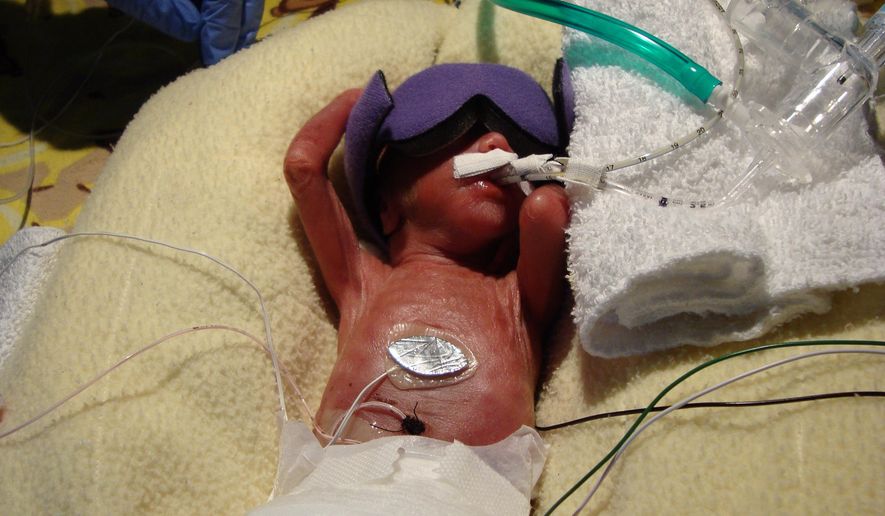News that about a quarter of the tiniest newborns survive with medical treatment has implications for neonatal bioethics and abortion politics, pro-life observers said Thursday.
“I think this has a great bearing” on courts and legislation, said David Prentice, vice president and research director at the Charlotte Lozier Institute.
For instance, the proposed Pain-Capable Unborn Child Protection Act “would line up exactly” with these increasing survival rates of newborns, he said, noting that the bill would bar most abortions after 20 weeks post-fertilization or 22 weeks gestation, due to concerns that fetuses feel pain at that age.
Moreover, medical science keeps advancing — “we anticipate and expect that [viability] will move even earlier,” said Mr. Prentice.
Dr. David Stevens, chief executive of the Christian Medical Association, agreed, saying that “the earlier we can salvage children, the harder it is for hard-core abortionists to dehumanize and depersonify children at this age.”
Children at this age feel pain — they grimace and withdraw during procedures — and “the more experience you have with them in” as newborns in intensive-care units, “the harder it is to justify” harming them in utero at the same age, Dr. Stevens said.
SEE ALSO: Highly educated women increasingly opting to have children: study
In 1980, he added, medical students like himself were talking about the viability of 28-week old newborns.
“Where will we be in another 20 years from now if we continue” with treatment of very premature newborns? asked Dr. Stevens. “Bottom line, you and I were us when we were that age and if somebody had taken our life, we wouldn’t be here today. Nobody else would have replaced us.”
According to federal data, about 12,000 babies are born between 22 and 25 weeks gestation in the United States every year. A full-term pregnancy is about 40 weeks.
The new study, published Thursday in the New England Journal of Medicine (NEJM), about a quarter of infants born at 22 weeks to 27 weeks have been able to survive with life-saving treatments in hospitals.
However, some hospitals do not view such fragile newborns as viable, and only offer palliative care, said the authors, including Dr. Edward F. Bell at the University of Iowa.
Researchers looked at the treatment of nearly 5,000 babies who born before 27 weeks gestation at 24 hospitals between April 2006 and March 2011 and were part of a National Institutes of Health research group.
The researchers found that only 22 percent of babies born at 22 weeks were given “active treatment,” like breathing machines, feeding tubes or heart resuscitation. In contrast, 72 percent of babies born only a week later received care, as did nearly all of the babies born later than that.
The actively treated newborns had higher survival rates: 23 percent versus 5 percent for all babies in the study born at 22 weeks, and 33 percent versus 24 percent for those born at 23 weeks.
Survival without severe impairment also was higher with treatment: 15 percent versus 3 percent at 22 weeks, and 25 percent versus 18 percent at 23 weeks.
Of the 24 hospitals, five always actively treated babies born at 22 weeks, while four hospitals never did, the study said.
In general, factors affecting preemie care include the condition of the newborn, medical prognosis, hospital resources and policies, insurance coverage and wishes of the parents.
Neonatal intensive care units can run into thousands of dollars a day in cost, and many very premature newborns have medical complications that threaten their lives or leave them disabled.
Parents need to know that “the hospital that you go to might determine what happens to your baby,” although many parents are not in a position to shop around when they find themselves in these emergency situations, said Dr. Bell.
They also should be given better information on survival odds, said another study leader, medical student Matthew Rysavy.
“A doctor might say ’no 22-week infant has ever survived,’” but that might mask the fact that doctors there don’t try, because they don’t consider such babies viable, he said.
“Simple interventions can make a huge difference in these young lives,” said Mr. Prentice, adding that doctors who do surgery on fetuses at 22 weeks in utero “understand that that’s a patient.”
Dr. Stevens said the only way medical science will gain knowledge in saving lives is by attempting to do so. “Right now, they’re working on an artificial womb,” he said. “We may be able in 15 or 20 years to keep alive and decrease the complications in children at much younger ages than 22 weeks.”
There is such a thing as “medical futility,” he said, but it can also be used as an excuse to do nothing. “Unfortunately, people tend to devalue the very young, in utero and out of utero,” he said, noting that if someone in their 40s has a 25 percent chance of surviving cancer, “no one would be arguing about this.”
• This article is based on part on wire service reports.
• Cheryl Wetzstein can be reached at cwetzstein@washingtontimes.com.




Please read our comment policy before commenting.